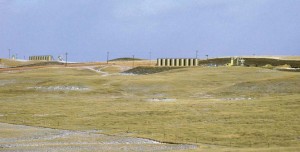Boomtown USA
During the Dust Bowl, Midwestern farmers traveled west, thrilled for the hope and promise of California. Today, where can one go in hope of a job? It may not be a sun-soaked beach or a modern-day Eden, but for now, there are jobs in North Dakota. Don’t expect to hear folk songs about it, but with an unemployment rate of about 3%, there is a renaissance of sorts taking place on the prairie. A few years ago, development on an oil deposit stretching under North Dakota, Montana, and Canada was begun and has driven incredible growth in western North Dakota.

The US Geological Survey estimates that at least 4 billion barrels are available to extract, and some estimates are even higher–up to four or five times that amount, which would make it the largest oil field ever found in North America. Numerous oil companies trust this to be the case and have poured vast amounts of money into the area. And where the money goes, people will follow.
Williston, ND, is the city at the center of the development of this oil field. The McDonald’s in Williston is one of the busiest in the country, and pays about $15 an hour. Before the oil boom, Williston was a town of about 12,000, making it large for North Dakota. The 2010 census counted 14,700 residents, but that does not take into account people in temporary housing. With the sudden influx of people moving for the oil jobs, there is not enough housing available. Hotels are booked for a hundred miles, filled by workers lucky enough to find a room. Newcomers are more likely to be camping or staying in their trucks. Homelessness is high, but most of the people have good jobs—there is just nowhere to stay. Some companies have built extensive camps with housing and cafeterias.
For now, all the problems are too much of a good thing. Still, there are reasons that this boom could soon go bust. How is that possible if this is such a huge deposit? People have known about the oil’s presence for quite a while, but only recently did we find out how to get it. The answer is hydraulic fracturing, popularly known as “fracking,” where fissures are formed in the rock, and sand and water are forced into the cracks to make space for the oil to come up. Fracking has drawn ire in other states for contaminating groundwater. Many environmental groups are strongly opposed to the use of fracking to drill for oil, and although it does not appear to be on the horizon yet, fracking bans are a possibility.
Although the numbers look good right now for the entire state, it is really only the western part of North Dakota that is doing well. The rest of the state is in a similar position to the rest of the country, although the state government’s budget is in good shape. The influx of people has created jobs in many areas, and given enough time, the current boom could allow western North Dakota to grow an economy that doesn’t just rely on oil. Eventually, the oil will be gone, and the boom could be cut short if hydraulic fracturing is determined too dangerous. With all the construction going on, it would be a good time to add other industries to the job market as well to increase long term growth. For now, North Dakota is an unlikely beacon of hope in the nation’s economy.
—–
“But wait,” says Bryan Baird. “Why should we care about the unemployment rate?”
3 Comments
Join the discussion and tell us your opinion.
Let’s go North Dakota!
Ten years from now, we’ll have ghost towns like in the West all over again.
Another factor is that North Dakota didn’t have a huge housing boom recently…